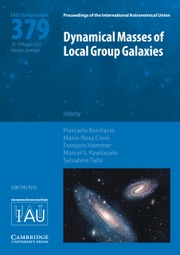Article contents
Shock-induced star cluster formation in colliding galaxies
Published online by Cambridge University Press: 27 April 2011
Abstract
We studied the formation process of star clusters using high-resolution N-body/smoothed particle hydrodynamics simulations of colliding galaxies. The total number of particles is 1.2×108 for our high resolution run. The gravitational softening is 5 pc and we allow gas to cool down to ~10 K. During the first encounter of the collision, a giant filament consists of cold and dense gas found between the progenitors by shock compression. A vigorous starburst took place in the filament, resulting in the formation of star clusters. The mass of these star clusters ranges from 105−8M⊙. These star clusters formed hierarchically: at first small star clusters formed, and then they merged via gravity, resulting in larger star clusters.
- Type
- Contributed Papers
- Information
- Proceedings of the International Astronomical Union , Volume 6 , Symposium S270: Computational Star Formation , May 2010 , pp. 483 - 486
- Copyright
- Copyright © International Astronomical Union 2011
References
- 2
- Cited by


